Across departments, instructors are experimenting with different ways to incorporate digital humanities methods and critical perspectives into undergraduate and graduate courses. Students are engaging with the digital by exploring computational methods, building models and reconstructions, and developing theoretical critiques and artistic creations. Below, we highlight a few current and upcoming courses taught by DH Fellows and other campus partners.
Fall 2015
The first set of courses featuring new components funded by DH at Berkeley made their debut this fall.
History of Art 192L: Mural Painting and the Ancient Americas 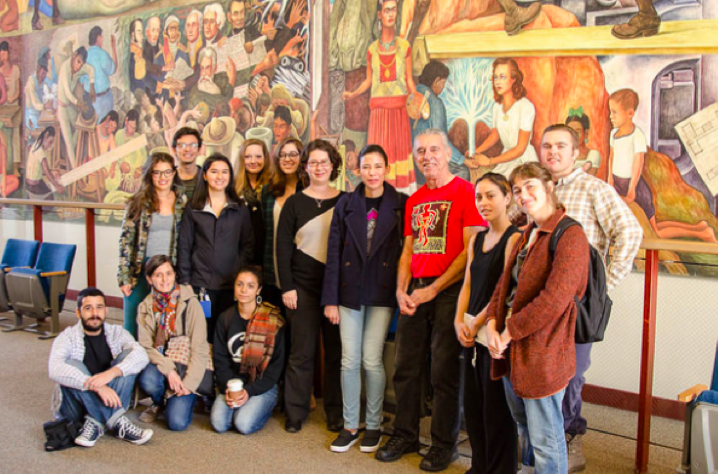
DH Fellow Lisa Trever, Assistant Professor in History of Art, expanded her course to include units on the spatial documentation and imaging of murals. In this mixed undergraduate and graduate seminar, students examined murals ranging from 100 BC to 1994 AD. Working with the staff at the Visual Resources Center and the Archaeological Research Facility, students explored various methods for documenting and modeling murals in their spatial contexts. By engaging with the challenges of documentation and representation, students were encouraged to “take seriously and analyze the spatial contexts of what might otherwise be represented as 2D images,” Trever explained. Students used panoramic photography to document mural fragments from the ancient Mexican city of Teotihuacan, Pan American Unity by Diego Rivera at City College of San Francisco, and Still Life and Blossoming Almond Trees by Diego Rivera at UC Berkeley’s Stern Hall. For their final projects, students created photogrammetric models of murals in Agisoft Photoscan, stitched together panoramic photos and mural fragments, modeled structures in Sketchup, and utilized tools like JS Story Map, Google Earth, and ArcGIS to illustrate temporally and spatially inflected analyses of various sites. Learn more about Trever’s ongoing research with photogrammetric models of murals at Pañamarca, Peru.
Image: HA 192L visits Pan American Unity by Diego Rivera at City College of San Francisco
Political Science 239T: Introduction to Computational Tools and Techniques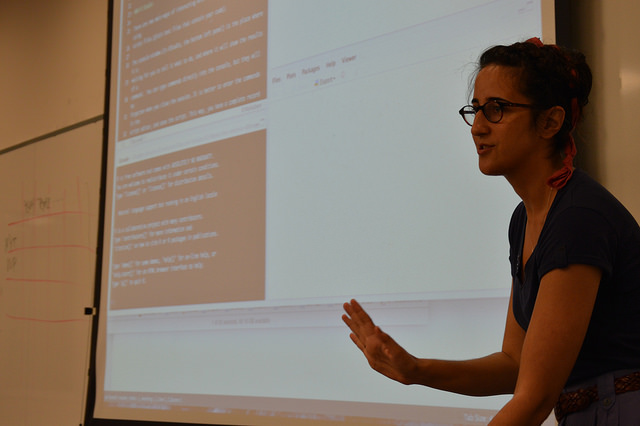
DH Fellows Rochelle Terman, PhD Candidate in Political Science, and Laura Stoker, Associate Professor in Political Science, piloted a computational methods course for graduate students. Rather than focusing on computational research in one discipline, this interdisciplinary course aimed at developing basic literacies in tools, terminologies, and programming languages. Emphasis was placed on best practices for reproducible research. Students began with learning the command line, Git, and the basics of Python and R. Students tried their skills out through a variety of applied assignments, including: accessing data via API, webscraping, computational text analysis, data visualization, geospatial analysis. Students came from a variety of disciplines, such as comparative literature, political science, sociology, and geography. Course materials and students’ final projects can be found on GitHub.
Image: DH Fellow Rochelle Terman teaching “Computational Text Analysis” at the DH at Berkeley Summer Institute
Spring 2016
Electronic Literature: A Critical Writing & Making Courses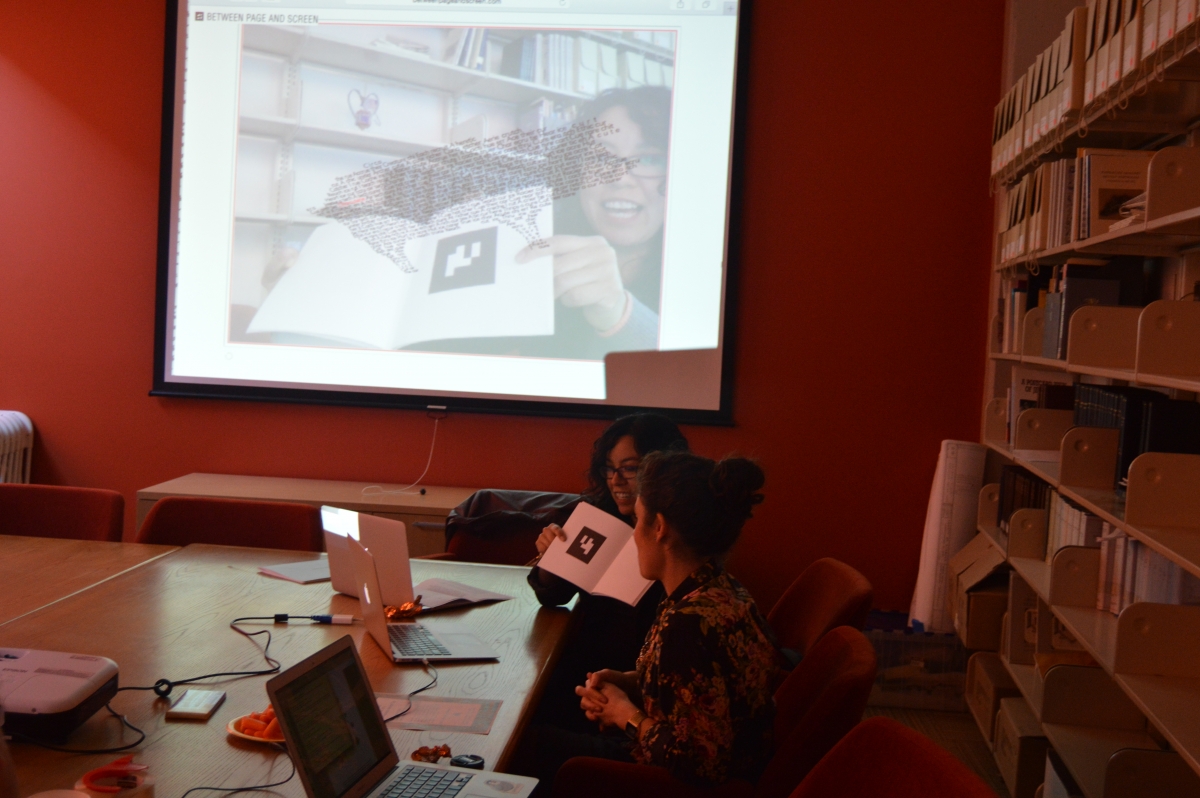
DH Fellow Alex Saum-Pascual, Assistant Professor in Spanish & Portuguese, has created a new undergraduate course, cross-listed in Spanish and New Media. Students will engage critically with hypertext narratives, kinetic poetry, bots, generators, interactive fiction, and more in both Spanish and English. In a weekly lab section, students will explore the affordances of these various mediums by creating their own pieces of e-lit with tools like Twine, Inform 7, Scratch, and New Hive. Visiting speakers will include Rui Torres, Associate Professor at University Fernando Pessoa, Portugal, and Leo Flores, Professor of English at the University of Puerto Rico: Mayagüez. Students’ final projects will be showcased at No Legacy || Literatura electrónica, an exhibit of electronic literature at Doe Library, co-curated by Saum-Pascual and her collaborator, Élika Ortega, Postdoctoral Researcher at the Institute for Digital Research in the Humanities at the University of Kansas.
Image: DH Fellow Alex Saum-Pascual and Élika Ortega demonstrate Between Page and Screen by Amaranth Borsuk and Brad Bouse
Music 158B: Digital Instrument Design for Musical Expression
The new Music 158B expands upon the Center for New Music and Audio Technology Music (CNMAT) course 158A: “Sound and Music Computing”. In this undergraduate course series, students investigate what it means to be musical in a digital context. Music 158A draws students from a wide variety of fields, such as music, computer science, cognitive science, and philosophy. In 158A, students develop an analytical foundation and technical skills for using technology to analyze sounds, model synthetic sounds, and combine various forms of time-bound data, such as gestures, sound, and other sensor-generated data. In Music 158B, taught by Rama Gottfried, PhD Candidate in Music and New Media, students will explore the practice and theory of contextual instrument design. Using the ODOT software library, developed by CNMAT, students will create new musical instruments and performance environments.
Information 290: Deconstructing Data Science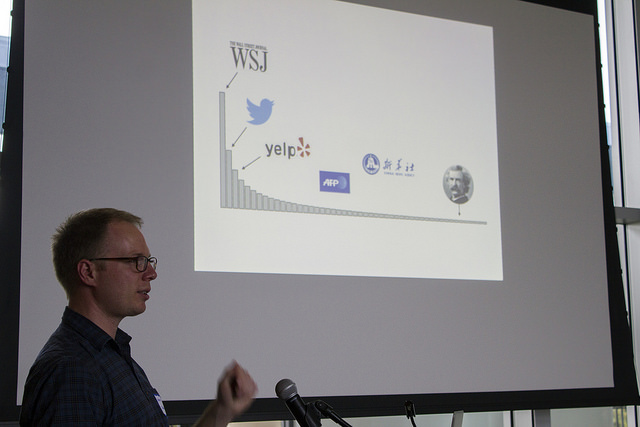
David Bamman, Assistant Professor at the School of Information, will be teaching a new course in critical data science. In this interdisciplinary graduate seminar, students will investigate the landscape of modern quantitative methods for treating data as a lens onto the world, surveying a range of methods in machine learning and data analysis that leverage information produced by people in order to draw inferences (such as discerning the authorship of documents and the political position of social media users, charting the reuse of language in legislative bills, tagging the genres of songs, and extracting social networks from literary texts). Students will critically engage with these algorithms and the models of the world they construct. No computational background is necessary; students will have the option of either implementing and evaluating a method on a dataset or writing a critique of an algorithm and a published work that has used it. Learn more about the upcoming course and Bamman’s interdisciplinary background.
Image: David Bamman at the DH at Berkeley Summer Institute, discussing the limitations of current natural language processing tools, which have mostly been trained on English newswire data. These tools perform poorly on literary English.
L&S 88-2: Literature as Data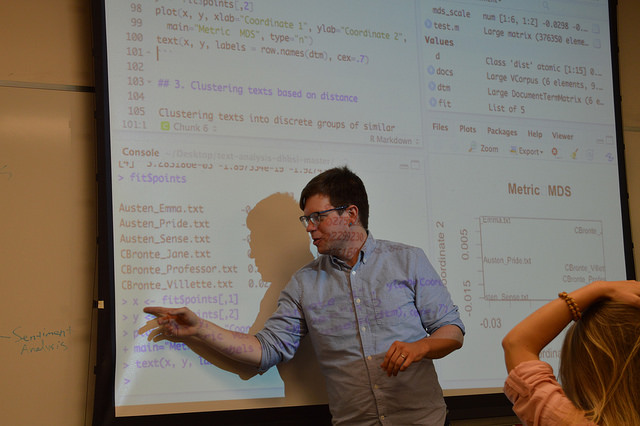
DH Consultant Teddy Roland will be teaching “Literature and Data” as a connector course for “Foundations of Data Science.” As students receive an introduction to computational and inferential thinking in “Foundations”, they will be able to immediately apply these methods to the study of literary texts in “Literature and Data”. The course will begin with theoretical texts and examples of traditional reading practices, especially “close reading” to discuss argument, interpretation, and evidence. After comparison with literary studies that utilize statistical methods and “distant reading”, students will discuss the limits of both new and traditional reading methods and how we make arguments based on data. The final paper will ask students to combine computational findings with close reading. Explore other data science connector courses.
Image: Teddy Roland teaching “Computational Text Analysis” at the DH at Berkeley Summer Institute
===
Interested in incorporating DH into your teaching? Apply for a DH at Berkeley course development grant. Grants are available for both creating new courses and adding components to existing courses. Explore funded courses that are currently in development.
Please contact digitalhumanities@berkeley.edu to discuss course proposals.